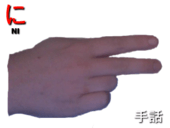Ni (kana)
に, in hiragana, or ニ in katakana, is one of the Japanese kana, which each represent one mora. The hiragana is written in three strokes, while the katakana in two. Both represent /ni/ although for phonological reasons, the actual pronunciation is [nʲi].
| ni | ||||
|---|---|---|---|---|
| ||||
| transliteration | ni | |||
| hiragana origin | 仁 | |||
| katakana origin | 仁 | |||
| spelling kana | 日本のニ (Nippon no ni) | |||
| kana gojūon | ||||||||||||||||||||||||||||||||||||||||||||||||||
|---|---|---|---|---|---|---|---|---|---|---|---|---|---|---|---|---|---|---|---|---|---|---|---|---|---|---|---|---|---|---|---|---|---|---|---|---|---|---|---|---|---|---|---|---|---|---|---|---|---|---|
|
||||||||||||||||||||||||||||||||||||||||||||||||||
Notably, the katakana (ニ) is functionally identical to the kanji for two (二), pronounced the same way, and written similarly.
に is used as a particle, as well as a word fragment. As a particle it generally expresses direction, with a similar function to the English "to."
i.e. Ton wa, Furansu "ni" ikimashita. Ton went "to" France.
Pan wa, Ton "ni" agemashita. Bread was given "to" Ton.
However, in clauses mentioning time, it is used as "at." For example: Roku ji ni shimashita. (I) did it at 6 o'clock.
| Form | Rōmaji | Hiragana | Katakana |
|---|---|---|---|
| Normal n- (な行 na-gyō) |
ni | に | ニ |
| nii nī |
にい, にぃ にー |
ニイ, ニィ ニー | |
| Addition yōon ny- (にゃ行 nya-gyō) |
nya | にゃ | ニャ |
| nyaa nyā, nyah |
にゃあ にゃー |
ニャア ニャー | |
| nyu | にゅ | ニュ | |
| nyuu nyū |
にゅう にゅー |
ニュウ ニュー | |
| nyo | にょ | ニョ | |
| nyou nyoo nyō, nyoh |
にょう にょお にょー |
ニョウ ニョオ ニョー |
| Other additional forms | ||||||||||||||||||
|---|---|---|---|---|---|---|---|---|---|---|---|---|---|---|---|---|---|---|
|
Stroke order
 Stroke order in writing に |
 Stroke order in writing ニ |

The hiragana に is made with three strokes:
- A vertical stroke from top to bottom.
- A short, horizontal stroke to the upper right of the first stroke, going from left to right.
- Another short, horizontal stroke at the bottom right of the first stroke, going from left to right.

The katakana ニ is made with two strokes:
- At the top, a horizontal stroke from left to right.
- Another, longer horizontal stroke under the first stroke
Other communicative representations
| Japanese radiotelephony alphabet | Wabun Code |
| 日本のニ Nippon no "Ni" |
 |
|
 |
 |
| Japanese Navy Signal Flag | Japanese semaphore | Japanese manual syllabary (fingerspelling) | Braille dots-123 Japanese Braille |
- Full Braille representation
| に / ニ in Japanese Braille | N + Yōon braille | ||||||
|---|---|---|---|---|---|---|---|
| に / ニ ni | にい / ニー nī | にゃ / ニャ nya | にゃあ / ニャー nyā | にゅ / ニュ nyu | にゅう / ニュー nyū | にょ / ニョ nyo | にょう / ニョー nyō |
| Look up に or ニ in Wiktionary, the free dictionary. |
| Character | に | ニ | ニ | |||
|---|---|---|---|---|---|---|
| Unicode name | HIRAGANA LETTER NI | KATAKANA LETTER NI | HALFWIDTH KATAKANA LETTER NI | |||
| Encodings | decimal | hex | decimal | hex | decimal | hex |
| Unicode | 12395 | U+306B | 12491 | U+30CB | 65414 | U+FF86 |
| UTF-8 | 227 129 171 | E3 81 AB | 227 131 139 | E3 83 8B | 239 190 134 | EF BE 86 |
| Numeric character reference | に | に | ニ | ニ | ニ | ニ |
| Shift JIS[1] | 130 201 | 82 C9 | 131 106 | 83 6A | 198 | C6 |
| EUC-JP[2] | 164 203 | A4 CB | 165 203 | A5 CB | 142 198 | 8E C6 |
| GB 18030[3] | 164 203 | A4 CB | 165 203 | A5 CB | 132 49 153 52 | 84 31 99 34 |
| EUC-KR[4] / UHC[5] | 170 203 | AA CB | 171 203 | AB CB | ||
| Big5 (non-ETEN kana)[6] | 198 207 | C6 CF | 199 99 | C7 63 | ||
| Big5 (ETEN / HKSCS)[7] | 199 82 | C7 52 | 199 199 | C7 C7 | ||
See also
Japanese Grammar
Reference
Handbook of Japanese Grammar - Masahiro Tanimori (Tuttle 1994)
- Unicode Consortium (2015-12-02) [1994-03-08]. "Shift-JIS to Unicode".
- Unicode Consortium; IBM. "EUC-JP-2007". International Components for Unicode.
- Standardization Administration of China (SAC) (2005-11-18). GB 18030-2005: Information Technology—Chinese coded character set.
- Unicode Consortium; IBM. "IBM-970". International Components for Unicode.
- Steele, Shawn (2000). "cp949 to Unicode table". Microsoft / Unicode Consortium.
- Unicode Consortium (2015-12-02) [1994-02-11]. "BIG5 to Unicode table (complete)".
- van Kesteren, Anne. "big5". Encoding Standard. WHATWG.


